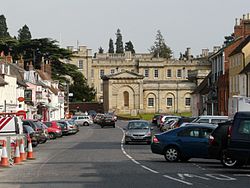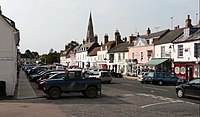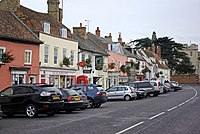Kimbolton
| Kimbolton | |
| Huntingdonshire | |
|---|---|
 Kimbolton Castle | |
| Location | |
| Grid reference: | TL102681 |
| Location: | 52°18’-0"N, 0°22’48"W |
| Data | |
| Postcode: | PE28 |
| Local Government | |
| Council: | Huntingdonshire |
Kimbolton is a large and historic village in Huntingdonshire. It stands in the west of the county, close to the border of Bedfordshire. It is a visually delightful little town and one whose history goes back hundreds of years. The Anglo-Saxons called the place Cynebealdstun after its founder Cynebeald, and with the Normans, came fair and market charters which led to the town's importance as a trading centre.
Today Kimbolton with its very wide street retains old and charming houses, and its church set in the heart of the place, is of the 13th to 15th centuries. The font though is an Anglo-Saxon relic. The manor, and that of nearby Swineshead belonged to King Harold, probably worshipped at the original church on this site when he visited his nearby hunting lodge.
Kimbolton Castle
The village's major feature is the castle, which stands at the end of the broad High Street. The castle is in fact a grand mansion on the site of the original stronghold that was built in the 13th century; Catherine of Aragon was imprisoned in the castle here for two long years and here she died, in 1536. A Tudor house replaced the original castle but this was almost wholly rebuilt in the early 18th century to designs by the famous Vanbrugh with Hawksmoor as his assistant, a pair who worked together at Blenheim Palace in Oxfordshire.
Kimbolton Castle is a splendid building with superb wall paintings by Pellegrini in the chapel and on the staircase, an earlier courtyard and a later Robert Adam gatehouse
The Castle today forms the main building of Kimbolton School, an independent day and boarding school. The School is itself an early foundation, having been set up originally in 1600.
The building can, however, be visited between 1400-1800 at Easter and Spring and Summer Bank Holidays and on Sundays from late July to late August.
About the village

Kimbolton is some 7 miles west of the county's biggest town, St Neots, and 7 miles east of Higham Ferrers.
A path leads out from Kimbolton through the woods to the small village of Swineshead, Huntingdonshire, a village historically linked to Kimbolton but in a detached part of the shire, surrounded by Bedfordshire territory.
Kimbolton and its neighbouring hamlet of Stonely successfully bridges the centuries, for it has modern houses and up-to-date shops which merge unobtrusively into the attractive and mellowed buildings of the past. Indeed, the most modern wares are sold from behind the multi-panel 'olde worlde' shop windows. The Mandeville Hall is a focal point of life and here meet, amongst others, the Women's Institute and Royal British Legion.
History
Kimbolton, and the lands of its soke, comprised the only estate of King Harold in Huntingdonshire. It is believed that Harold had a hunting lodge nearby. Kimbolton and its church, St Andrew's, appear in the Domesday Book, compiled in 1086. Swineshead was part of the estate also, and continued into the modern era in common ownership.
The main road through Kimbolton (once part of the main trunk road from Birmingham to Felixstowe, now bypassed) bends through four tight right angles in quick succession. Originally, the road travelled directly through the outskirts of the village, nearer to the River Kym to the north.
The manor has been held for many centuries by the Montagu family, the Dukes of Manchester.
Statute Fair
In 1200, a prominent local landowner, Geoffrey Fitz Peter, Earl of Essex and Chief Justice to King John, who built the first castle on the present site, received a Royal charter to hold a market and fair in Kimbolton. There is still a fair every September, known as the "Statute Fair" - referred to affectionately by locals as the "Statty". Continuation of this fair (despite the chaos which formerly ensued when this meant partial closure of a trunk road) and a plaque marking the site of the market cross are claimed by some as evidence that Kimbolton is a town and still has a right to hold a weekly market. The main road was diverted to its present course to take it through the market place and increase toll revenue. 800 years later, as a result of numerous vehicles striking walls and houses near the sharp bends, car transporters are not allowed in the village.
Kimbolton Airfield
In Second World War, the USAF 379th Bombardment Group was stationed at the nearby Kimbolton Airfield from May 1943 to June 1945.
Kimbolton Fireworks
Kimbolton Fireworks, a well-known manufacturer of fireworks and organiser of public fireworks displays, is based in Kimbolton.[1] It grew from the extracurricular activities of a Kimbolton school chaplain and chemistry master, Rev Ron Lancaster, sometimes dubbed the "master blaster pastor."
Outside links

- The annual Country Fayre at Kimbolton (at the castle)
- Kimbolton Web site
- Kimbolton School (the castle)
- The parish church